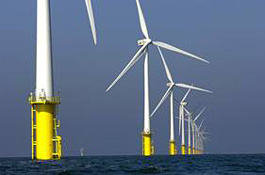
Super Grid: the answer to Europe's
energy needs?
Mar 5, 2009 - Thijs Westerbeek - Radio Netherlands
Worldwide
The European Commission wants to build powerful
electricity transmission networks connecting the North
Sea, the Mediterranean and the Baltic region. This
would help bring more wind and water energy onto the
market.
The biggest problem with wind power is its unpredictability.
When the wind does not blow there is no electricity
and when it blows too hard you cannot use all of it.
A new European network of underground and undersea
high-voltage direct current cables (HVDC), which would
be longer and more powerful than the current overhead
lines, could offer a solution. The problem caused
by fluctuations in the supply of wind-generated energy
will only increase in the coming years.
 Economic
crisis aside, the supply of oil is not infinite; sooner
or later, we're going to run out of oil and wind energy
- particularly wind parks at sea - will inevitably
play a greater role. The European high-voltage transmission
grid could transport electricity to wherever it is
needed: electricity generated by strong winds blowing
in Spain's Bay of Biscay could be transported to Italy
or Austria. Economic
crisis aside, the supply of oil is not infinite; sooner
or later, we're going to run out of oil and wind energy
- particularly wind parks at sea - will inevitably
play a greater role. The European high-voltage transmission
grid could transport electricity to wherever it is
needed: electricity generated by strong winds blowing
in Spain's Bay of Biscay could be transported to Italy
or Austria.
Super Grid
A large-scale system for transmitting electricity
is the only way to stabilise the fluctuating supply
of solar and wind energy and guarantee an adequate
supply of electricity at all times. The renowned British
green energy guru James Woudhuysen put it like this:
"We have to think big about it. In fact what they
are, as sources of energy, is astronomical. They
harness the power of the sun and the wind to generate
very large flows of energy, rather than stocks of
energy like fossil fuels. But these flows only exist
on a very large and astronomical scale. So you just
can't get very far with a little windmill or solar
panel above your house. You have to cover deserts
with solar panels and the same goes for wind and
water power; you have to think big because that's
what the technicalities of those kinds of energy
sources are all about."
Energy experts at Germany's University of Kassel
really understand the 'big idea'. Energy systems modelling
expert Professor Gregor Czisch and his colleagues
say Europe could satisfy all of its energy needs by
transforming its existing electricity grinds into
one clean Super Grid that uses only renewable sources.
Seventy percent of electricity needs would come from
wind energy, with hydroelectric power stations in
Scandinavia supplying the necessary back-up capacity.
Profitable
Professor Wil Kling, an energy transition expert at
the Eindhoven University of Technology, is studying
ways of integrating wind energy into the mainstream
power network. He is not as optimistic as his colleagues
in Kassel, but he does believe it will be possible
to generate around 50 percent of Europe's energy needs
from greener sources. Professor Kling is also positive
about the economic feasibility of his proposed network.
It will cost billions to construct since it involves
HVDC cables capable of transporting an, until recently
unimaginable, capacity. However, this also means it
will be all the more profitable. The country that
receives the power pays for the imported electricity.
Professor Kling knows it will work because an undersea
HVDC cable laid between the Netherlands and Norway
a few years ago will start generating profits very
soon:
"The Norned line between the Netherlands and Norway
has generated more than 100 million euros in the
space of a year. If the trend continues, then it
will have paid for itself within a few years. From
an economic point of view, it was a very sound investment".
And that is certainly true when one considers that
the Norned line cost just 400 million euros.
Wind parks
The whole idea of a Super Grid does of course raise
the question of whether it makes sense to construct
large-scale offshore wind parks before the Super Grid
is available. However, Han van den Berkel, director
of Darwind, an offshore wind-turbine factory, is very
clear about it:
"I want both. The sea is enormous; there are numerous
possibilities to generate energy at numerous locations.
And that has to happen; in order to make the Super
Grid effective you also need offshore wind parks".
European Energy Commissioner Andris Piebalgs has
already taken the first steps towards realising the
Super Grid. He is due to hold talks with Germany,
Sweden and Denmark about coupling the fluctuating
supply of German and Danish wind-generated energy
with Swedish hydroelectric power plants.
|



 Economic
crisis aside, the supply of oil is not infinite; sooner
or later, we're going to run out of oil and wind energy
- particularly wind parks at sea - will inevitably
play a greater role. The European high-voltage transmission
grid could transport electricity to wherever it is
needed: electricity generated by strong winds blowing
in Spain's Bay of Biscay could be transported to Italy
or Austria.
Economic
crisis aside, the supply of oil is not infinite; sooner
or later, we're going to run out of oil and wind energy
- particularly wind parks at sea - will inevitably
play a greater role. The European high-voltage transmission
grid could transport electricity to wherever it is
needed: electricity generated by strong winds blowing
in Spain's Bay of Biscay could be transported to Italy
or Austria.